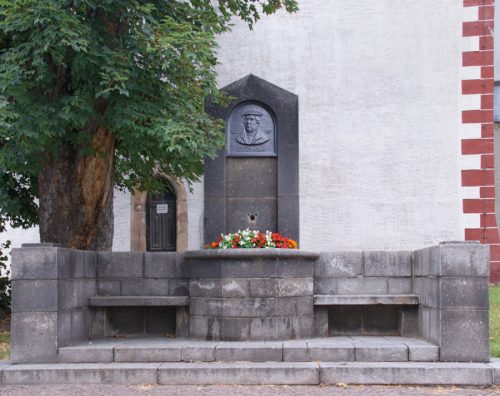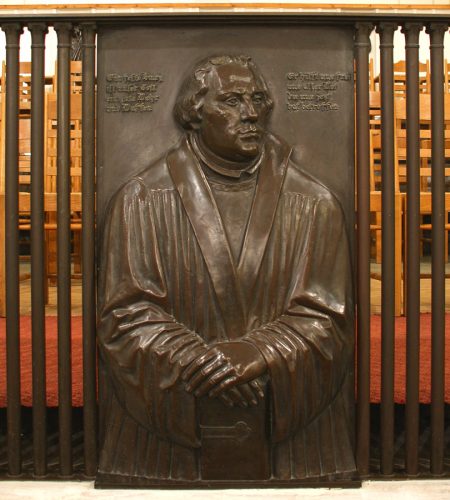Wurzen is a stop on the Way of Luther (Lutherweg) in Saxony. The Lutherweg – like the Way of St James – leads through the lovely old quarter of Wurzen to St Mary’s Church.
Martin Luther himself did not come to Wurzen – it was presumably the existence of the Catholic rulers who resided in Schloss Wurzen that prevented him from entering the town. Nevertheless, the reformer Martin Luther put his stamp on Wurzen and its Church of St Mary. Since 1542 Protestant services have been held in the church. This is remarkable in view of the fact that the Catholic bishops resided next door in Schloss Wurzen until 1581.
In front of the church stands the so-called Luther Fountain, with a portrait of Martin Luther and stone benches where visitors can rest. The fountain was donated by the Chapter and by respected citizens of Wurzen, the commercial counsellor August Schmidt, the legal counsellor Eduard Taubert, the school headmaster Oskar Burkhardt, the quarry owner Georg Zimmermann and the engineer Reinhard Klinkhardt.
Luther is present in several places in the church. A bronze relief attached to the balustrade of the singers’ gallery in the west choir bears a portrait of Martin Luther and the first words of his famous hymn “Ein feste Burg ist unser Gott” (A Mighty Fortress Is Our God). The bronze relief is part of the interior furnishings created in 1931-32 by Prof. Georg Wrba. A great-great-grandson of Martin Luther, Johan Martin Luther (11th November 1619 – 13th July 1669), owner of the manor in nearby Hohburg, was a canon of the Wurzener Dom from 1649 until his death in 1669. A memorial tablet in black and white marble commemorates him in the east choir. The well-preserved tombstone of his first wife, Regine, née Leyser, who died on 8th October 1653, has been set up directly behind the porch in the south aisle. For Luther researchers there is one more connection: Johan Wilhelm Luther, the son from the marriage of Johan Martin Luther with Margarete Sophie, née Hülsemann, was also a canon at the Wurzener Dom.
In the archive (visits by appointment only) there is a small bust of Luther made from Meissen porcelain in 1817, the 300th anniversary of the Reformation. The inscription on the front of the base runs as follows: LVTHERO POST TRIA SECVLA NEPOTUM PIETAS MDCCCXVII. The archive also holds a commemorative medallion made in 1630 with a portrait of Martin Luther with an inscription on the back: “IETZT IUBILIRT DIE CHRISTENHEIT; UND DANCKT GOTT FUR DIE GNADENZEIT: DA D: LUTHERS HAND UND MUND; SEIN WORT DER KIRCHEN MACHTE KUNDT” (Christians now rejoice and thank God for the age of grace, as the church proclaims His word through the hand and mouth of Luther.”
Anyone who is interested in finding out about further activities of Martin Luther in Wurzen outside the church should look for information about the so-called Wurzen Feud, which also went down in history as the Pastry War and ended peacefully thanks to the mediation of Martin Luther.
The Chapter of the Wurzener Dom wishes all pilgrims on the Way of Luther a pleasant stay in the Church of St Mary.


